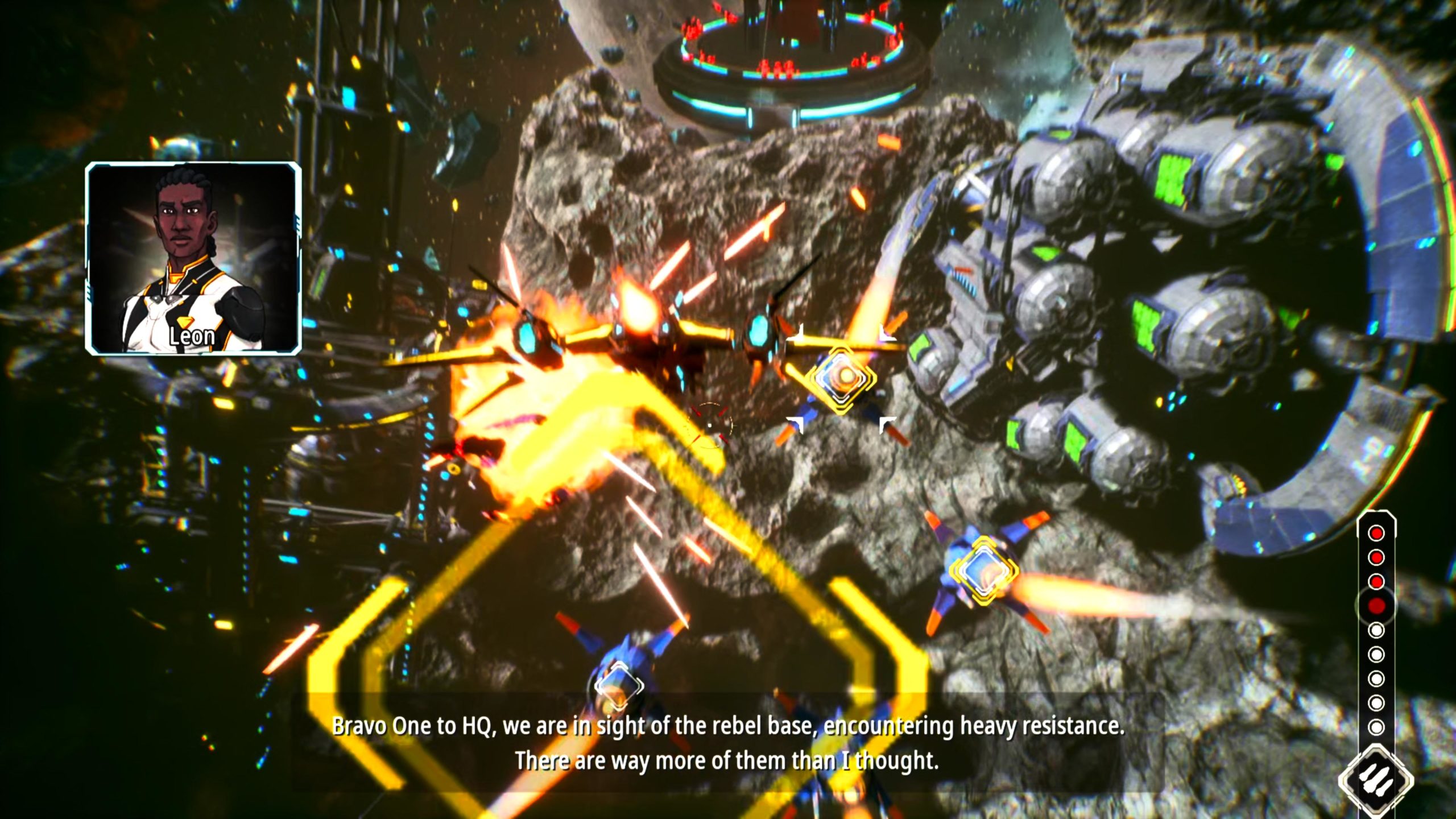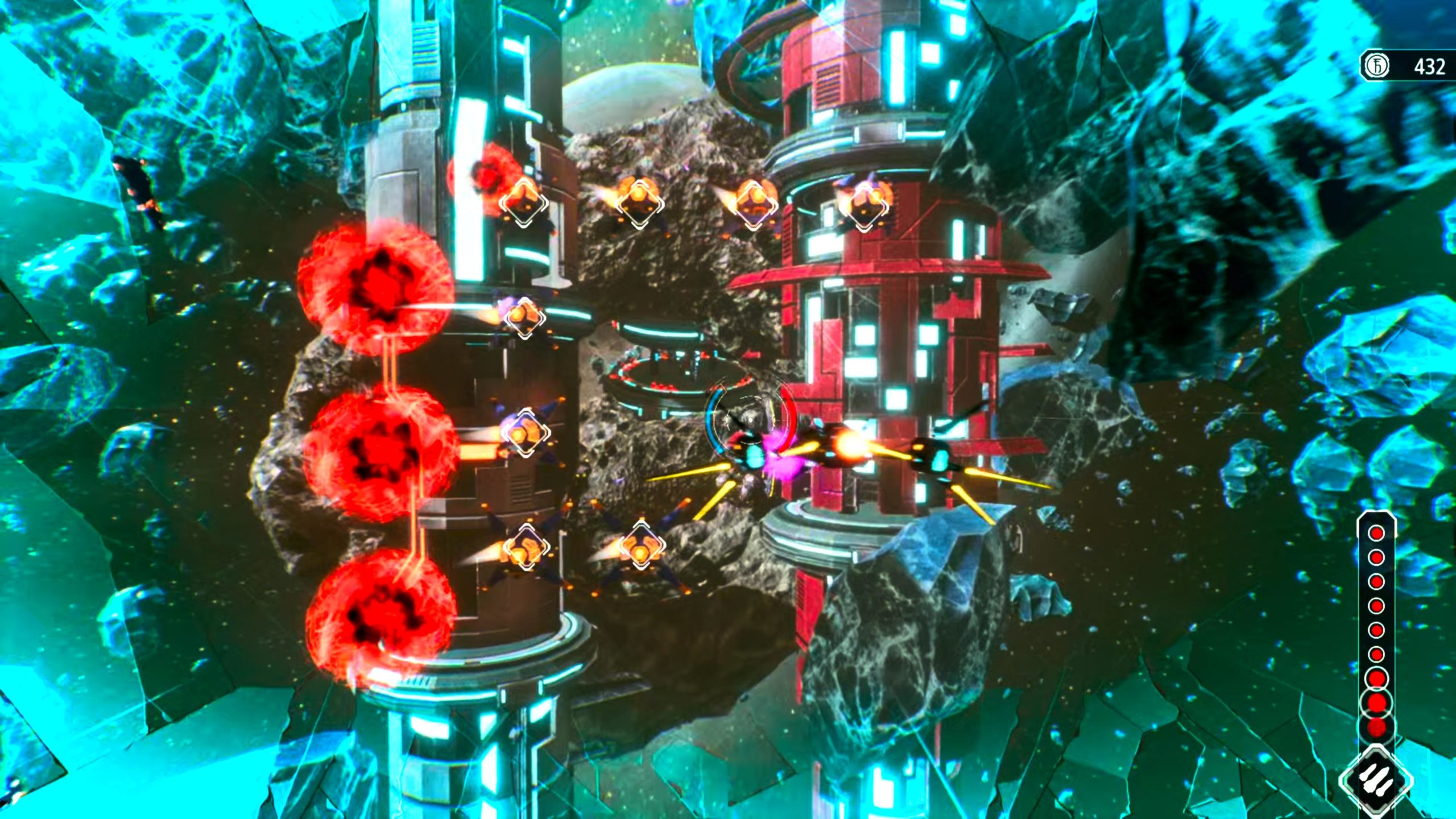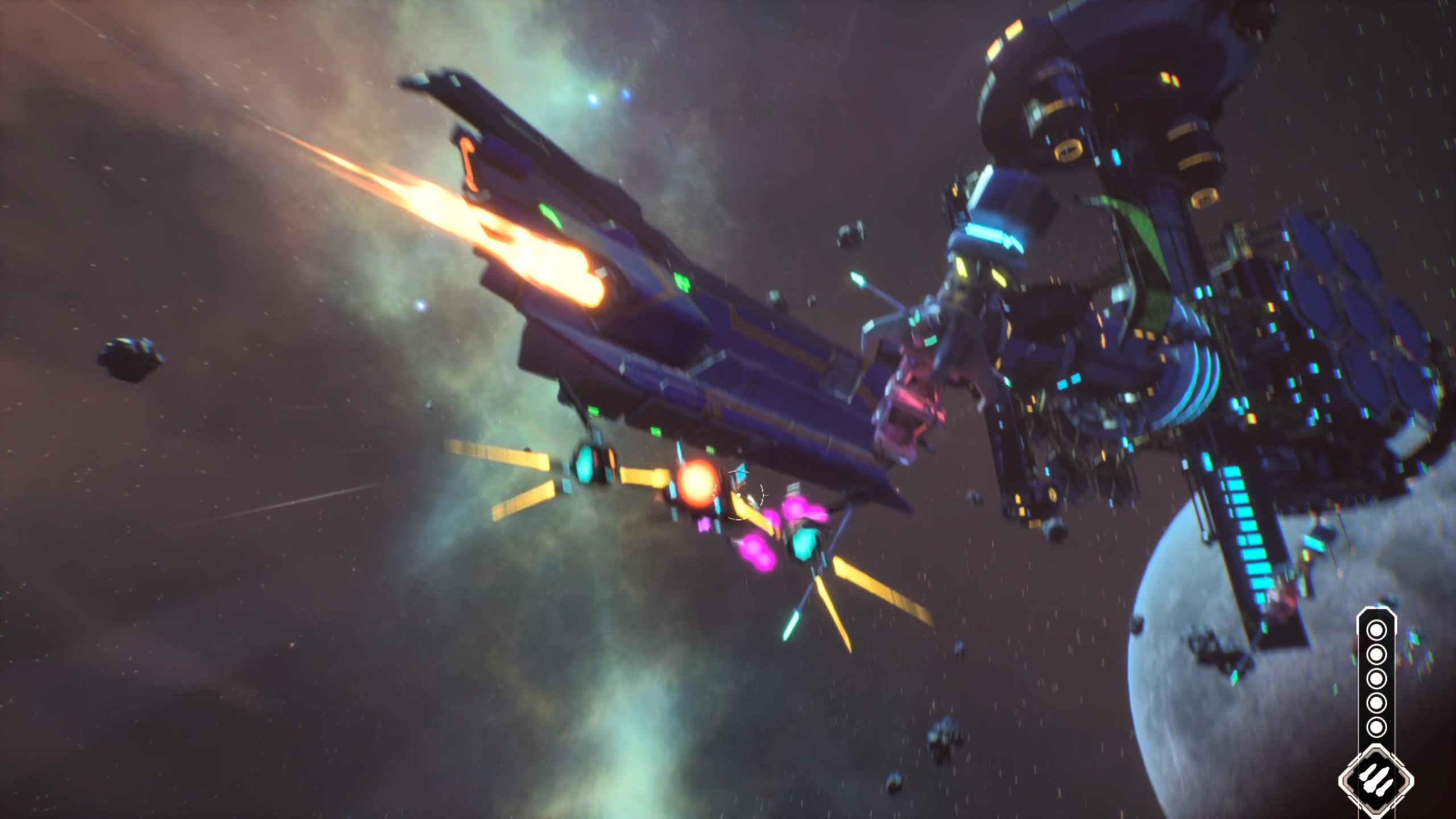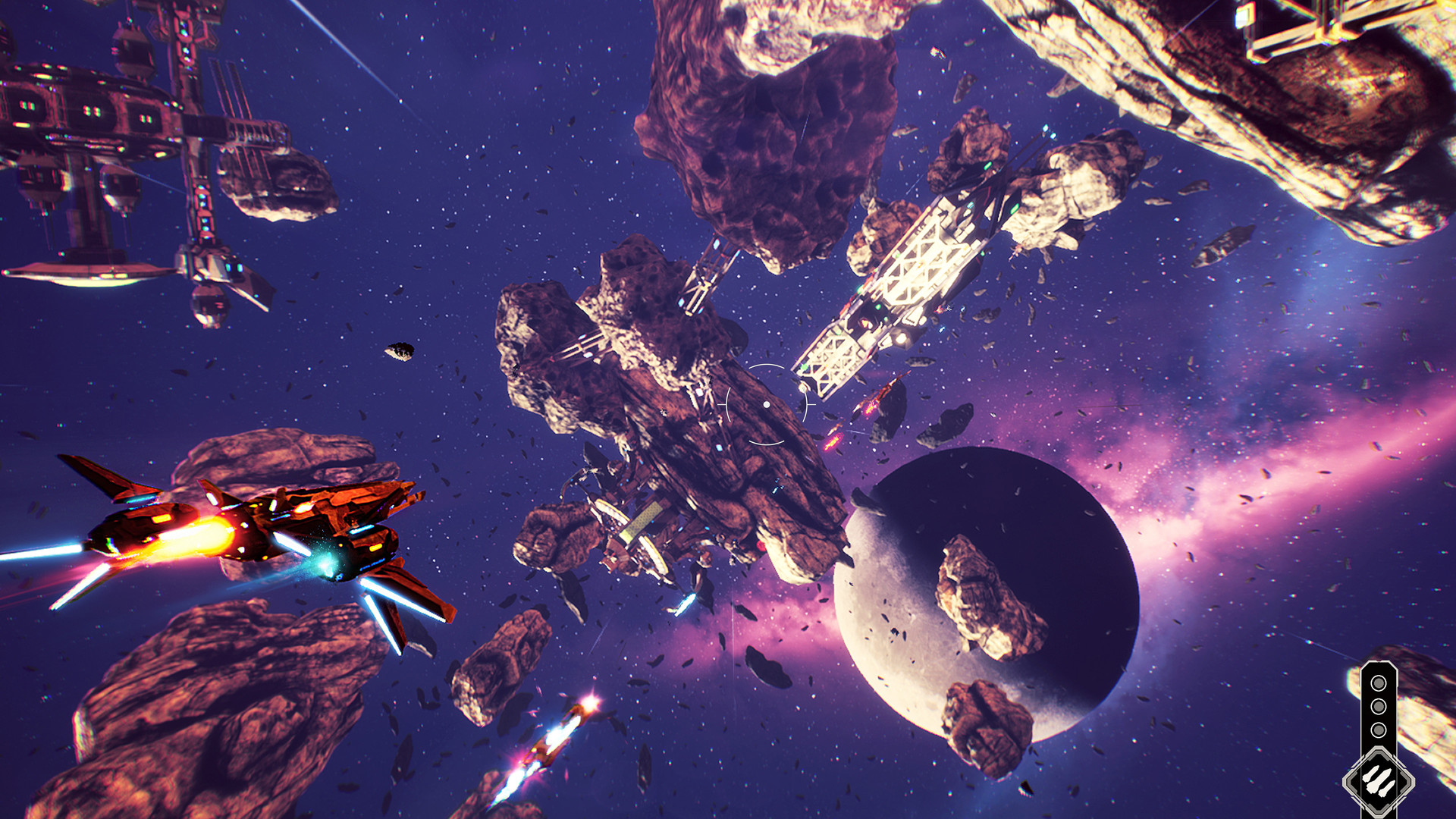Redout Space Assault Review (PS4) – Skinny LyLatte
Sometimes spaceflight sims can get a bit too complex; all that x, y, and z axis can really make flying in zero-gee pretty tricky. You can get all turned around easily, end up chasing enemies round and round in circles, and that’s no one’s idea of a good time. So some bright spark once upon a time decided to do away with the need to control the ship and decide where to go, and just let you do the fun stuff, ie the shooting and the dodging manoeuvres. Redout Space Assault is made in true on-rails Starfox 64/Lylat Wars style, but also has a couple of full-control recon missions thrown in for good measure.
If you were expecting a Wipeout-style antigrav racer, you’re probably a little confused by the direction of the second Redout game. Gone are the F-Zero tribute race tracks, the white-knuckle speeds, and instead we are blasting into space in a Super Orbital Recon Fighter, during the colonisation of Mars. You’d think everyone would be happy with putting people on the red planet, but guess what? Humans couldn’t possibly just get along. Instead the colonisation has turned into a full-on rebellion and it’s up to you to stop it.

The story of Redout Space Assault is pretty underwhelming and largely superfluous. It’s just a bare bones excuse for a lot of missions flying into asteroids and enemy orbital bases and shooting stuff. It’s the far future and humanity has colonised the moon. Instead of a time of peace and plenty, the solar system is in flux. People are suffering, they can’t earn enough, and need aid to stay afloat. Poseidon Industries are trying to establish a physical link to Mars that would supposedly help the people, but rebels hailing from the moon and calling themselves Genesis are attacking Poseidon and causing havoc.
It’s in this maelstrom that Leon, space assault pilot, finds himself on his first day. Your fancy moves in your first few missions catch the attention of Carl Harp Poseidon himself, and you’re quickly tractor-beamed into a larger story of rebels and big corporations in space. After the first section, of which there are nine total, the story really falls away and there is just mission after mission of reconning bases, racing pirates, or chasing runaway rebel freighters. The story fades into the background even as the voice cast of tiny 2D static drawings tries to convince you that events of import are happening. They really aren’t. It’s a bit of a missed opportunity for a game that could have told a tale rife with corporate backstabbing and the ramifications of capitalism in the future, but this isn’t that. The characters are also completely forgettable – this is not Fox McCloud and Slippy Toad.

There’s a massive forty-three of these levels but it’s rare that any are even five minutes long, a holdover from the game originally being designed for mobile and short-stint handheld gaming. A quick bit of mental arithmetic will tell you that’s about three and a half hours, at a push. But you will likely find there are choke points you have to do over a few times.
Missions can involve a number of different scenarios as described above, but they really boil down to going somewhere (which you aren’t in control of) and shooting stuff. You can further split the missions into two types, ones where you fly on-rails – enemies lining up in front of you like 3D space invaders, and dodging left and right across the screen – or, the free-movement levels – which are usually the recon or chasing types, where you need to control direction, and where enemies are usually confined to single large freighters (or bosses).
These two types of mission control can make Redout Space Assault feel a bit like two different games. One apes the Lylat wars/Starfox style and the other the Everspace style. Considering neither is as good as those examples, it might have made better sense to concentrate on one, and ditch the other completely.
Personally, I favoured the on-rails approach, as this allowed a more arcade feel that felt right, letting me worry about dodging and shooting, and also crucially letting me see and experience a little more, without having to worry about chasing and dogfights all the time. The free-movement levels felt strange in comparison, not balanced correctly, and as if it was part of a game that involved exploration, which this never does. Boost controls are strange between the two modes; on-rails your boost does almost nothing – if the game wants you to take ten seconds to cross an expanse, your boost won’t make it go faster, or at least it doesn’t feel like it, it just blurs the screen edges. In the free-movement levels boost mode is overpowered, causing you to boost all over. When your normal speed is at that frustrating point, just too fast to comfortably chase something, you have to constantly slow down and get fired on easily, and boost sends you dodging away by miles.
Enemies and freighters are dull polygons that only look marginally more interesting than they did back on the last Starfox. They fire a stream of slow- and fast-moving beam and particle weapons, and the occasional missile you’ll need to roll to avoid. The levels on the other hand can look nice, with lots of vibrant colour and plenty of all-around design from every angle as would be seen in space.
Your own weapons seem to be glitched, at least on PS4/5 where I was playing Redout. You can hold R2 to lock-on and fire your missiles and that all works fine, but the game says you can fire manually with L2, using a scattershot or a railgun. However, in all the missions I played, I was only able to fire the L2 weapon in one mission. Any other time it simply did nothing, no matter how much I clicked, with no explanation as to why.

Your ship comes in a whole heap of nice skins and paintjobs, but it has four basic stats you need to concern yourself with. Hull is the armour of the ship itself, Shields protect your hull from damage in the first place, Weapons is the power for the system assigned to L2 that doesn’t work, and Missiles upgrades your missiles, funnily enough. You earn points and can collect coins during runs and use these to upgrade your ship. There are also power ups in the form of cards after each battle that you can either discard or keep for multiple battles.
However it’s really not made clear what difference your upgrades are making – there’s not much in the way of stats to show the hull strength increasing for example. What’s worse is that until I had cracked level 2 on my missiles it did nothing to improve the missiles, leaving me high and dry in a later level with vastly underpowered missiles because I’d been sharing my upgrades out evenly. Some missions require very fast damage dealing, far faster than my meager missiles could manage, and then failed me over and over, without explanation as to what to do to improve. I went back and earned more points, concentrated solely on missiles until I was able to fire two more per salvo. This was enough to complete said mission. But the lack of explanation meant having to work out why I was failing without help.
Missions in general also seem to give you infinite lives, which takes all the tension out of the game. When an enemy required the super-fast killing before escaping the area, I ended up just throwing myself into the action without any care to dodge, spamming fire, and respawning perfectly aligned behind their engines again, and only by doing that was I able to kill the enemy fast enough for the mission not to time out.

Redout Space Assault still has some glitches in how missions handle, in addition to the ones I’ve already described. I had a few instances where in free-movement levels, runaway freighters would get themselves stuck on some asteroid-linking-gantry or space debris and I had to keep boosting away and then coming in hot again to kill it, but the level clearly called for it to have continued flying around.
The voice acting is pretty poor all round, with some laughably bad enemies talking to you over the comm. The sound quality is also off quite often, resulting in missing some of the words they say anyway. But it really doesn’t matter, the story is so generic and obvious that there’s no real need to listen. I did, for the purposes of review, so that you don’t have to.
Also of note is a slightly strange set of trophies, in that the first five chapters are gold trophies, but chapter six through nine are just bronze trophies, thereby encouraging me to what? Only play half the campaign?

Redout Space Assault is enjoyable enough, and works well enough to give you a few fun hours. However consistent glitches, unbalanced difficulty spikes, non-functional weaponry and a decidedly generic and forgettable story bog it down from an enjoyable arcade shooter on-rails, to a pretty average one with issues.
It feels like quite a missed opportunity. At one point half way through I got a weapon power up floating after a kill for the first time in the entire game, and I realised what I wished it was like. I wished it had been on-rails pretty much constantly, like a 3D version of a classic shmup like Darius. Most of the game’s issues arose in the free-movement style levels, bringing down the fun of the other sections. I wished its story had taken the themes it hinted at and actually explored them.
Redout Space Assault feels like two games; an enjoyable arcade shooter on rails, and a free-movement space-sim with no exploration. Glitches, unbalanced difficulty, and a lack of any worthwhile story weigh down what could have been much better.

Redout Space Assault is out now on PS4 (review platform), Nintendo Switch, Xbox One, and PC/Steam.
Developer: 34BigThings
Publisher: 34BigThings
Disclaimer: In order to complete this review, we were provided with a promotional copy of the game. For our full review policy, please go here.
If you enjoyed this article or any more of our content, please consider our Patreon.
Make sure to follow Finger Guns on our social channels –Twitter, Facebook, Twitch, Spotify or Apple Podcasts – to keep up to date on our news, reviews and features
